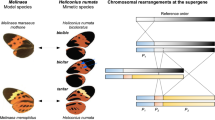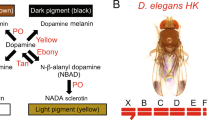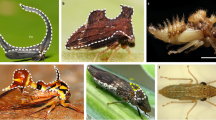Abstract
The colour patterns decorating butterfly wings provide ideal material to study the reciprocal interactions between evolution and development. They are visually compelling products of selection, often with a clear adaptive value, and are amenable to a detailed developmental characterization1. Research on wing-pattern evolution and development has focused on the eyespots of the tropical butterfly Bicyclus anynana2. There is quantitative variation for several features of eyespot morphology3,4,5 but the actual genes contributing to such variation are unknown. On the other hand, studies of gene expression patterns in wing primordia have implicated different developmental pathways in eyespot formation6,7,8,9,10,11. To link these two sets of information we need to identify which genes within the implicated pathways contribute to the quantitative variation accessible to natural selection. Here we begin to bridge this gap by demonstrating linkage between DNA polymorphisms in the candidate gene Distal-less (Dll) and eyespot size in B. anynana.
This is a preview of subscription content, access via your institution
Access options
Subscribe to this journal
Receive 51 print issues and online access
$199.00 per year
only $3.90 per issue
Buy this article
- Purchase on Springer Link
- Instant access to full article PDF
Prices may be subject to local taxes which are calculated during checkout


Similar content being viewed by others
References
Nijhout, H. F. The Development and Evolution of Butterfly Wing Patterns (Smithsonian Institute, Washington DC, 1991).
Brakefield, P. M. The evolution–development interface and advances with the eyespot patterns of Bicyclus butterflies. Heredity 80, 265–272 (1998).
Monteiro, A. F., Brakefield, P. M. & French, V. The evolutionary genetics and developmental basis of wing pattern variation in the butterfly Bicyclus anynana. Evolution 48, 1147–1157 (1994).
Monteiro, A. F., Brakefield, P. M. & French, V. Butterfly eyespots: the genetics and development of the color rings. Evolution 51, 1207–1216 (1997).
Monteiro, A. F., Brakefield, P. M. & French, V. The genetics and development of an eyespot pattern in the butterfly Bicyclus anynana: response to selection for eyespot shape. Genetics 146, 287–294 (1997).
Carroll, S. B. et al. Pattern formation and eyespot determination in butterfly wings. Science 265, 109–114 (1994).
Carroll, S. B. Developmental regulatory mechanisms in the evolution of insect diversity. Development (Suppl.) 217–223 (1994).
Brakefield, P. M. et al. Development, plasticity and evolution of butterfly eyespot patterns. Nature 384, 236–242 (1996).
Keys, D. N. et al. Recruitment of a hedgehog regulatory circuit in butterfly eyespot evolution. Science 283, 532–534 (1999).
Weatherbee, S. D. et al. Ultrabithorax function in butterfly wings and the evolution of insect wing patterns. Curr. Biol. 9, 109–115 (1999).
Brunetti, C. R. et al. The generation and diversification of butterfly eyespot color patterns. Curr. Biol. 11, 1578–1585 (2001).
Palopoli, M. F. & Patel, N. H. Neo-Darwinian developmental evolution: can we bridge the gap between pattern and process? Curr. Opin. Gen. Dev. 6, 502–508 (1996).
Stern, D. L. Perspective: evolutionary developmental biology and the problem of variation. Evolution 54, 1079–1091 (2000).
Mackay, T. F. C. Quantitative trait loci in Drosophila. Nature Rev. Genet. 2, 11–20 (2001).
Brakefield, P. M. & French, V. Butterfly wings: the evolution of development of colour patterns. BioEssays 21, 391–401 (1999).
Nijhout, H. F. Pattern formation on lepidopteran wings: determination of an eyespot. Dev. Biol. 80, 267–274 (1980).
French, V. & Brakefield, P. M. Eyespot development on butterfly wings: the focal signal. Dev. Biol. 168, 112–123 (1995).
Panganiban, G., Nagy, L. & Carroll, S. B. The role of the Distal-less gene in the development and evolution of insect limbs. Curr. Biol. 4, 671–675 (1994).
Kreitman, M. Nucleotide polymorphism at the alcohol dehydrogenase locus of Drosophila melanogaster. Nature 304, 412–417 (1983).
Long, A. D. et al. High resolution mapping of genetic factors affecting abdominal bristle number in Drosophila melanogaster. Genetics 139, 1273–1291 (1995).
Taylor, B. A., Wnek, C., Schroeder, D. & Phillips, S. J. Multiple obesity QTLs identified in an intercross between the NZO (New Zealand obese) and the SM (small) mouse strains. Mamm. Genome 12, 95–103 (2001).
Wijngaarden, P. J. & Brakefield, P. M. The genetic basis of eyespot size in the butterfly Bicyclus anynana: an analysis of line crosses. Heredity 85, 471–479 (2000).
Edwards, M. D., Stuber, C. W. & Wendel, J. F. Molecular-marker-facilitated investigations of quantitative-trait loci in maize. I. Numbers, genomic distribution and types of gene action. Genetics 116, 113–125 (1987).
Lander, E. S. & Botstein, D. Mapping Mendelian factors underlying quantitative traits using RFLP Linkage maps. Genetics 121, 185–199 (1989).
Robinson, R. Lepidoptera Genetics (Pergamon, Oxford, 1971).
Lai, C. G., Lyman, R. F., Long, A. D., Langley, C. H. & Mackay, T. F. C. Naturally-occurring variation in bristle number and DNA polymorphisms at the scabrous locus of Drosophila melanogaster. Science 266, 1697–1702 (1994).
Long, A. D., Lyman, R. F., Morgan, A. H., Langley, C. H. & Mackay, T. F. C. Both naturally occurring insertions of transposable elements and intermediary frequency polymorphisms at the achaete–scute complex are associated with variation in bristle number in Drosophila melanogaster. Genetics 154, 1255–1269 (2000).
Doerge, R. W. & Churchill, G. A. Permutation test for multiple loci affecting a quantitative character. Genetics 142, 285–294 (1996).
Falconer, D. S. & Mackay, T. F. C. Introduction to Quantitative Genetics 4th edn (Addison Wesley Longman, Harlow, Essex, 1996).
Marec, F. Synaptonemal complexes in insects. Int. J. Insect Morphol. Embryol. 25, 205–233 (1996).
Acknowledgements
We thank K. Koops for rearing the butterflies, and B. Zwaan for help with the crosses; C. Brunetti, J. Selegue and S. Carroll for the B. anynana cDNA library, the P. coenia Dll probe and the Dll antibody; N. Glansdorp for help with wing extractions, and G. Lammers for help with the confocal microscopy; K. Broman for deriving the likelihood function; F. Marec for information on butterfly chromosomes; M. Brittijn for help with the figures; and A. Monteiro, H. Teotónio and B. Zwaan for comments on the manuscript. This work was supported by the Portuguese Foundation for Science and Technology and the Luso-American Foundation under the Gulbenkian Program (P.B.), the Human Frontier Science Program Organization (P.M.B.) and the US National Institute of Health (A.D.L.).
Author information
Authors and Affiliations
Corresponding author
Rights and permissions
About this article
Cite this article
Beldade, P., Brakefield, P. & Long, A. Contribution of Distal-less to quantitative variation in butterfly eyespots. Nature 415, 315–318 (2002). https://doi.org/10.1038/415315a
Received:
Accepted:
Issue Date:
DOI: https://doi.org/10.1038/415315a
This article is cited by
-
The flexible stem hypothesis: evidence from genetic data
Development Genes and Evolution (2017)
-
Focusing on butterfly eyespot focus: uncoupling of white spots from eyespot bodies in nymphalid butterflies
SpringerPlus (2016)
-
Distal-less induces elemental color patterns in Junonia butterfly wings
Zoological Letters (2016)
-
Genome editing in butterflies reveals that spalt promotes and Distal-less represses eyespot colour patterns
Nature Communications (2016)
-
What makes eyespots intimidating–the importance of pairedness
BMC Evolutionary Biology (2015)
Comments
By submitting a comment you agree to abide by our Terms and Community Guidelines. If you find something abusive or that does not comply with our terms or guidelines please flag it as inappropriate.



